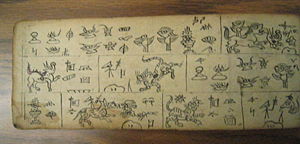2010 may just be wrapping up, but I am already deep into thinking about and planning how we are going to present educational resources for our exhibitions in 2011. In May of next year we will be opening an exhibition tentatively called Quentin Roosevelt’s China: Ancestral Realms of the Naxi. This show will present works of art created by the Naxi people who live in Western China near the border of Tibet that were collected by Quentin Roosevelt II in the late 1930’s and early 1940’s. This exhibition will be exposing visitors to works of art from a culture they may be unfamiliar with and also to a member of a prominent American family with whom they may also be unfamiliar.
Quentin Roosevelt, the son of Theodore Roosevelt Jr and Eleanor Butler Alexander Roosevelt, traveled to Western China when he was only 19 in part to do research for his senior thesis at Harvard on the Naxi. The Naxi practice a religion called Dongba, which shares many similarities to the Tibetan Bon religion. The Dongba priests utilize a pictographic script is one of the only (if not the only) pictographic scripts still in use today. So as you can imagine, the exhibition has a lot of interesting ground to cover!
Since the exhibition will be focusing on Naxi works of art, we decided that the Explore Area will focus on Quentin Roosevelt and his process of learning about the Naxi. As he traveled from Oyster Bay, New York to Lijiang, in China, Quentin Roosevelt wrote devotedly to his mother and family members about what he saw and experienced along the way. Last week I met with our art storage coordinator Zachary Harper to photograph a binder of these letters and ephemera that had been written by or to Quentin Roosevelt and saved by his family members.
In college I studied Cultural and Postcolonial Studies and we always talked about the importance of the archive as a location to trace the history of power and knowledge. As a museum educator I always try to push students I am working with the consider and utilize primary source documents in their research about art and culture as much as possible. There’s something really powerful about being so close to objects that witnessed powerful parts of history. As Zach and I looked through the binders and read the letters I was struck at the first hand account I was getting of all the complicated politics and power struggles that were going on in Asian in the early 1940’s, which unfortunately are subjects American history classes tend to gloss over pretty quickly. Looking at these yellowing letters on hotel stationary written in perfect western script it suddenly it all felt so much more real. Zach and I kept looking at each other as we read passages from the letters saying “Wow!” I also felt closer to Quentin Roosevelt as a historical figure, someone who was engaged in world politics, in doing cultural and art historical research, and as someone focused on exploring and experiencing the world.
As I work on putting together the explore area for this exhibition this is the feeling I want to convey: a feeling of discovery, of what it is like to go on a journey and learn about a culture outside of your own first hand, and to get a sense of what Quentin Roosevelt himself felt like as he was learning about the Naxi. To me this emphasizes why objects and archives are so important and the role that museums play in not only preserving them, but presenting them to the for all learn and feel the sense that these things have been witness to history that is still relevant to us today.





One Response to American History First Hand